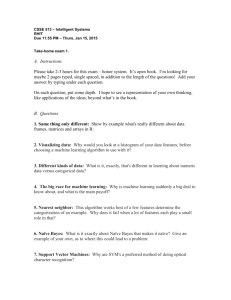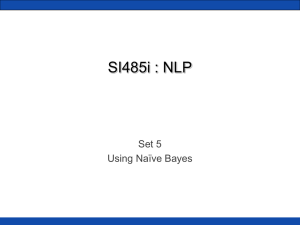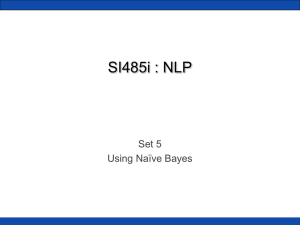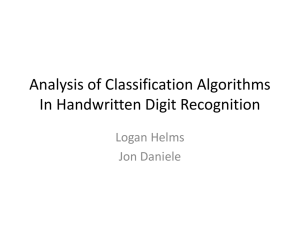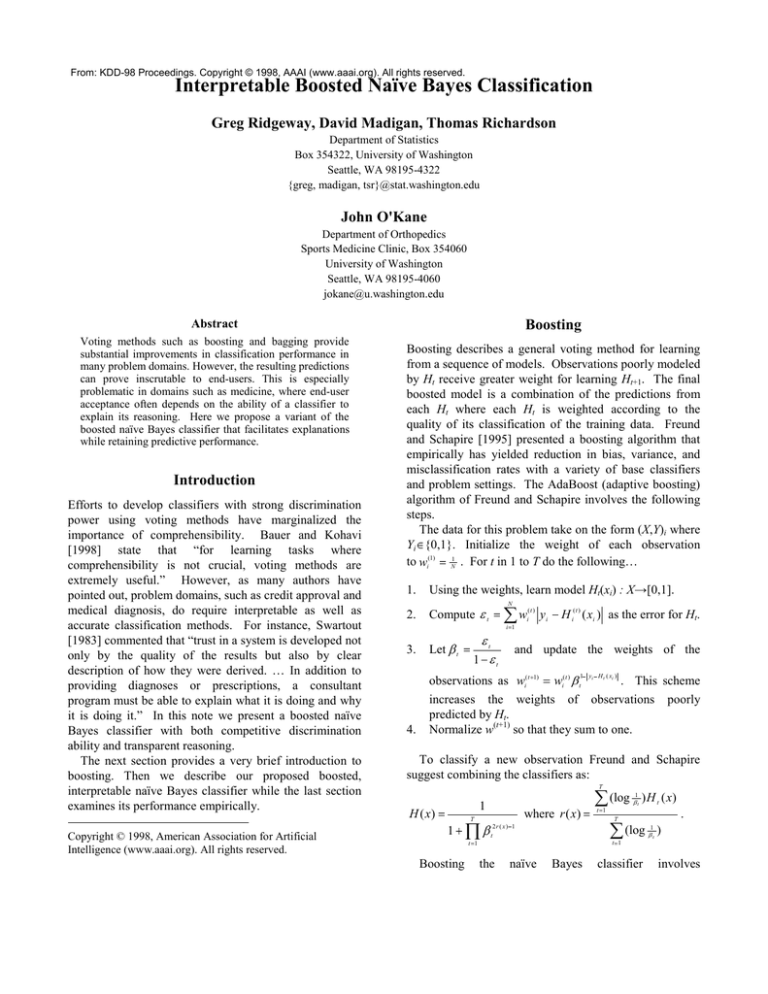
From: KDD-98 Proceedings. Copyright © 1998, AAAI (www.aaai.org). All rights reserved.
Interpretable Boosted Naïve Bayes Classification
Greg Ridgeway, David Madigan, Thomas Richardson
Department of Statistics
Box 354322, University of Washington
Seattle, WA 98195-4322
{greg, madigan, tsr}@stat.washington.edu
John O'Kane
Department of Orthopedics
Sports Medicine Clinic, Box 354060
University of Washington
Seattle, WA 98195-4060
jokane@u.washington.edu
Abstract
Voting methods such as boosting and bagging provide
substantial improvements in classification performance in
many problem domains. However, the resulting predictions
can prove inscrutable to end-users. This is especially
problematic in domains such as medicine, where end-user
acceptance often depends on the ability of a classifier to
explain its reasoning. Here we propose a variant of the
boosted naïve Bayes classifier that facilitates explanations
while retaining predictive performance.
Introduction
Efforts to develop classifiers with strong discrimination
power using voting methods have marginalized the
importance of comprehensibility. Bauer and Kohavi
[1998] state that “for learning tasks where
comprehensibility is not crucial, voting methods are
extremely useful.” However, as many authors have
pointed out, problem domains, such as credit approval and
medical diagnosis, do require interpretable as well as
accurate classification methods. For instance, Swartout
[1983] commented that “trust in a system is developed not
only by the quality of the results but also by clear
description of how they were derived. … In addition to
providing diagnoses or prescriptions, a consultant
program must be able to explain what it is doing and why
it is doing it.” In this note we present a boosted naïve
Bayes classifier with both competitive discrimination
ability and transparent reasoning.
The next section provides a very brief introduction to
boosting. Then we describe our proposed boosted,
interpretable naïve Bayes classifier while the last section
examines its performance empirically.
Copyright © 1998, American Association for Artificial
Intelligence (www.aaai.org). All rights reserved.
Boosting
Boosting describes a general voting method for learning
from a sequence of models. Observations poorly modeled
by Ht receive greater weight for learning Ht+1. The final
boosted model is a combination of the predictions from
each Ht where each Ht is weighted according to the
quality of its classification of the training data. Freund
and Schapire [1995] presented a boosting algorithm that
empirically has yielded reduction in bias, variance, and
misclassification rates with a variety of base classifiers
and problem settings. The AdaBoost (adaptive boosting)
algorithm of Freund and Schapire involves the following
steps.
The data for this problem take on the form (X,Y)i where
Yi{0,1}. Initialize the weight of each observation
to wi(1) N1 . For t in 1 to T do the following…
1.
Using the weights, learn model Ht(xi) : X
w
N
2.
Compute t
t
i 1
(t )
i
yi
H
(t )
i
[0,1].
( xi ) as the error for Ht.
3.
Let t
4.
. This scheme
observations as wi( t 1) wi( t ) t
increases the weights of observations poorly
predicted by Ht.
Normalize w(t+1) so that they sum to one.
1 t
and update the weights of the
1 yi H t ( xi )
To classify a new observation Freund and Schapire
suggest combining the classifiers as:
T
H ( x) 1
T
1 t2 r ( x ) 1
where r ( x) the
naïve
t 1
1
t
) H t ( x)
Bayes
.
T
(log
t 1
t 1
Boosting
(log
classifier
1
t
)
involves
(log )1 21 e
substituting in the above algorithm Ht = Pt(Y=1|X) where
estimation of Pt(Y=1|X) assumes that
T
Pt(Y=1|X) Pt(Y=1)Pt(X1|Y=1) Pt (Xd|Y=1).
The boosted naïve Bayes classifier has proven effective –
see, for example, Bauer and Kohavi [1998]. Elkan’s
application of boosted naïve Bayes won first place out of
45 entries in the data mining competition KDD'97 (Elkan
[1997]). However, while the regular naïve Bayes
approach leads to elegant and effective explanations (see,
for example, Madigan, et al [1996] and Becker, et al
[1997]), the AdaBoost-ed version destroys this feature.
Boosting and Weights of Evidence
Under the naïve Bayes assumption, writing the log-odds
in favor of Y=1 we obtain the following:
log
P (Y 1 | X )
P(Y 0 | X )
log P(Y 1) log
P (Y 0)
P( X
j 1
w w
1)
| Y 0)
P( X j | Y
d
j
d
0
j 1
j
(X j )
The wj are the weights of evidence described by Good
[1965]. A positive wj(Xj) indicates that the state of Xj is
evidence in favor of the hypothesis that Y=1. A negative
weight is evidence for Y=0. Spiegelhalter and Knill-Jones
[1984] advocate the use of weights of evidence
extensively in medical diagnosis and propose evidence
balance sheets as a means of viewing the reasoning
process of the naïve Bayes classifier. Madigan, et al
[1996] and Becker, et al [1997] develop this idea further.
In what follows, we derive a “boosted weight of
evidence” that the explanation facilities of Madigan, et al
[1996] and Becker, et al [1997] can use directly.
Writing the AdaBoost combined classifiers, H(x), in the
form of a log-odds simplifies the combination procedure.
log
H ( x)
1 H ( x)
T
log (
T
t 1
t 1
t
each probability model casts a log-odds vote for or
against classification into Y=1 where each models’ vote is
weighted according to its quality. So letting t
1
log
1
t
log
1
t
and assuming a naïve Bayes model for Pt(Y=1|X), a
boosted estimate for the log-odds in favor of Y=1 is:
T
t 1
t
t
log
1)
P ( X | Y 0)
boosted prior weight of evidence Pt (Y
Pt (Y
1) 0) d
T
j 1 t 1
t
log
Pt ( X j | Y
t
j
t
P (Y 1| X )
log t
Pt ( Y 0| X )
1
we can rewrite the log-odds of the combined classifiers as
a function of the log-odds of each Pt(•):
j
This again is just a naïve Bayes classifier where the
estimates of the weights of evidence have been biased by
boosting. The sigmoid function transforms the boosted
log-odds to a boosted predicted probability as
Using the fact that
1 e
Pt (Y 1 | X )
.
Pt (Y 0 | X )
j 1
(log )(1 2P (Y 1 | X ))
1
t
boosted weight of evidence from X
T
P ( Y 0| X )
P (Y 1| X )
log 1 ) log
d
(1 2r ( x)) log 1| X ) 1
2
The linear approximation to the sigmoid function is
exact at 0 and loses precision as the argument moves
away from 0. On the probability scale, the two functions
agree at P(Y=1|X) = ½. This is precisely the point where
classification is the most in doubt. On the probability
interval [0.25, 0.75] the absolute error of the
approximation is less than 0.025. In the region near the
extremes the approximation preserves the sign of the
AdaBoost combined hypothesis. Although the probability
estimates will differ in this case, both methods will make
the same classification.
Finally, to help maintain some probabilistic
interpretation of the final model and to remove some of
the effect of the number of boosting iterations, we
normalize the classifier weights 12 log 1 . Intuitively,
T
Pt (Y
1 .
Substituting the Taylor approximation to the sigmoid
1 1 1 x 1 x 3 Ox 5 up to the linear
function 1 e x 2 4 48
term produces a linear combination of the log-odds from
each boosted naïve Bayes classifier:
2 r ( x ) 1
t
t
Pt ( Y 1| X )
Pt ( Y 0| X )
t
t 1
t 1
t 1
log
P(Y
1| X ) 1
.
1 exp( log odds)
Performance
The substantial changes to the classifier combination step
proposed in the previous section may have produced a
voting method with different discrimination properties. In
this section we show empirically on five datasets that the
misclassification rates for this new method are
comparable to those generated by the AdaBoost
algorithm. We note that each one of these datasets
concerns a problem domain where human understanding
of the machine reasoning process is likely to be important.
Knee diagnosis
Diabetes
Credit approval
Coronary artery disease
Breast tumors
N
Predictors
99
768
690
303
699
26
8
15
13
9
Positive
cases
44%
35%
44%
44%
34%
boosting iterations.
Table 2 compares the misclassification rates of the three methods. Both boosting
methods demonstrate marginal absolute improvements in
misclassification rate for most of the datasets. However,
the most important result from Table 2 is that boosted
weight of evidence naïve Bayes almost perfectly matches
the performance of the AdaBoost method.
We have also examined aspects of the performance of
the boosted weight of evidence naïve Bayes classifier that
go beyond just misclassification rate. The so-called “Brier
Score” is a proper scoring rule that considers both
discrimination ability and calibration:
B
( y Pˆ (Y 1))
1
N
Knee diagnosis
Diabetes
Credit approval
Coronary artery
disease
Breast tumors
Naïve
Bayes
14.0%
(5.0%)
25.0%
(2.0%)
16.8%
(2.0%)
18.4%
(3.0%)
3.9%
(1.0%)
AdaBoost
13.8%
(5.5%)
24.4%
(2.5%)
15.5%
(2.1%)
18.3%
(3.2%)
3.8%
(1.0%)
Weight of
evidence
13.4%
(5.7%)
24.4%
(2.6%)
15.5%
(2.1%)
18.3%
(3.3%)
3.8%
(1.0%)
Table 2: Misclassification rates (standard deviation)
For each dataset we created 100 training sets randomly
composed of two-thirds of the data. Then we compared
the misclassification rate of naïve Bayes, AdaBoost naïve
Bayes, and the proposed boosted weight of evidence
naïve Bayes on the remaining one-third of the cases
comprising the test set. Cross-validation on the training
data yielded an estimate of the optimal number of
2
i
Yates [1982] and Spiegelhalter [1986] provide an
extensive discussion of this scoring rule that has its roots
in meteorology. Table 3 indicates that boosting generally
decreases the mean Brier score and again the boosted
weight of evidence naïve Bayes classifier is competitive.
Table 1 : Datasets used for comparison
In a retrospective study, O’Kane, et al [1998] use the
weight of evidence boosted naïve Bayes classifier to
diagnose candidates for knee surgery at a sports medicine
clinic. They present boosted parameter estimates and
example evidence balance sheets that physicians can
easily interpret and utilize in diagnosis. A prospective
study is in progress. The remaining datasets are from the
UCI repository (Merz and Murphy [1998]).
i
Knee diagnosis
Diabetes
Credit approval
Coronary artery
disease
Breast tumors
Naïve
Bayes
0.107
(0.040)
0.170
(0.010)
0.127
(0.020)
0.135
(0.020)
0.035
(0.009)
AdaBoost
0.108
(0.038)
0.164
(0.011)
0.112
(0.012)
0.132
(0.016)
0.035
(0.009)
Weight of
evidence
0.103
(0.036)
0.164
(0.011)
0.113
(0.012)
0.130
(0.021)
0.034
(0.009)
Table 3: Mean Brier score (standard deviation)
When a probabilistic prediction model assigns, e.g., a
30% probability to a positive outcome, one would like
30% of such cases to actually have a positive outcome.
Various authors have proposed calibration scores and
plots that attempt to represent this property. Calibration
plots (Copas [1983]) show whether probabilistic
predictions are calibrated. Figure 1 displays an example
calibration plot for a random split of the data. The
perfectly calibrated predictor will have a straight line.
Across the five datasets, the plots generally show that the
boosting methods provide improved calibration, but the
two boosting methods are indistinguishable.
1.0
0.8
0.6
Merz, C.J., & Murphy, P.M. [1998]. UCI Repository of
machine learning databases. Irvine, CA: University of
California, Department of Information and Computer
Science.
http://www.ics.uci.edu/~mlearn/MLRepository.html
0.4
Naive
Bayes
0.2
AdaBoost
O’Kane, John, Ridgeway, G., Madigan, D. [1998]. In
submission.
0.0
Observed probability
Madigan, David, Mosurski K., and Almond, R.G. [1996]
Explanation in Belief Networks. Journal of
Computational and Graphical Statistics, 6, 160-181.
WoE
0.0
0.2
0.4
0.6
0.8
1.0
Predicted probability
Figure 1: Example calibration plots (credit data)
Further research may show that boosting smoothes
predictions in such a way that improves their calibration.
Summary
The proposed boosting by weight of evidence method
offers an easily interpretable model with discrimination
power equivalent to that of AdaBoost. More importantly,
this shows that voting methods do not necessarily have to
dispense with interpretability in order to obtain
classification strength.
Acknowledgements
A grant from the National Science Foundation supported
this work (DMS 9704573).
References
Bauer, E. and Kohavi, R. [1998] An Empirical
Comparison of Voting Classification Algorithms:
Bagging, Boosting, and Variants. Machine Learning, vv,
1-33.
Becker, B., Kohavi, R., Sommerfield, D. [1997]
Visualizing the Simple Bayesian Classifier. KDD 1997
Workshop on Issues in the Integration of Data Mining
and Data Visualization.
Copas, J.B. [1983]. Plotting p against x. Applied
Statistics, 32, 25-31.
Elkan, C. [1997]. Boosting and Naïve Bayes Learning.
Technical Report No. CS97-557, September 1997, UCSD.
Good, I. J. [1965] The Estimation of Probabilities: An
Essay on Modern Bayesian Methods, MIT Press.
Spiegelhalter, D.J. and Knill-Jones, R.P. [1984] Statistical
and Knowledge-based Approaches to Clinical Decisionsupport Systems, with an Application in Gastroenterology
(with discussion). Journal of the Royal Statistical Society
(Series A), 147, 35-77.
Spiegelhalter, David J. [1986] Probabilistic Prediction in
Patient Management and Clinical Trials. Statistics in
Medicine, 5, 421-433.
Swartout, W. [1983] XPLAIN: A system for creating and
explaining expert consulting programs. Artificial
Intelligence, 21, 285-325.
Yates,
J.F.
[1982]
External
correspondence:
decomposition of the mean probability score.
Organisational Behaviour and Human Performance, 30,
132-156.


